Netarsudil: Difference between revisions
No edit summary |
No edit summary |
||
| Line 212: | Line 212: | ||
|othersTitle=Others | |othersTitle=Others | ||
|useInOthers=(Description) | |useInOthers=(Description) | ||
|administration= | |administration======Ophthalmic===== | ||
*Administer in the evening. | |||
*When used concomitantly with other ophthalmic products intended to lower intraocular pressure, separate administration of each product by at least 5 minutes. | |||
|monitoring=*A reduction in intraocular pressure indicates efficacy. | |||
= | |||
|overdose= | |overdose= | ||
Revision as of 17:06, 20 July 2018
Editor-In-Chief: C. Michael Gibson, M.S., M.D. [1]; Associate Editor(s)-in-Chief: Yashasvi Aryaputra[2];
Disclaimer
WikiDoc MAKES NO GUARANTEE OF VALIDITY. WikiDoc is not a professional health care provider, nor is it a suitable replacement for a licensed healthcare provider. WikiDoc is intended to be an educational tool, not a tool for any form of healthcare delivery. The educational content on WikiDoc drug pages is based upon the FDA package insert, National Library of Medicine content and practice guidelines / consensus statements. WikiDoc does not promote the administration of any medication or device that is not consistent with its labeling. Please read our full disclaimer here.
Black Box Warning
|
Warning Title
See full prescribing information for complete Boxed Warning.
Condition Name: (Content)
|
Overview
Netarsudil is a Acetylcholine release inhibitor, Adrenergic receptor agonist that is FDA approved for the (type of indication of drug) of a list of indications, separated by commas.. There is a Black Box Warning for this drug as shown here. Common adverse reactions include a list of adverse reactions, separated by commas..
Adult Indications and Dosage
FDA-Labeled Indications and Dosage (Adult)
Condition 1
- Dosing Information
- (Dosage)
Condition 2
- Dosing Information
- (Dosage)
Off-Label Use and Dosage (Adult)
Guideline-Supported Use
Condition 1
- Developed by: (Organisation)
- Class of Recommendation: (Class) (Link)
- Strength of Evidence: (Category A/B/C) (Link)
- Dosing Information/Recommendation
- (Dosage)
Condition 2
- Developed by: (Organisation)
- Class of Recommendation: (Class) (Link)
- Strength of Evidence: (Category A/B/C) (Link)
- Dosing Information/Recommendation
- (Dosage)
Non–Guideline-Supported Use
Condition 1
- Dosing Information
- (Dosage)
Condition 2
- Dosing Information
- (Dosage)
Condition 3
- Dosing Information
- (Dosage)
Pediatric Indications and Dosage
FDA-Labeled Indications and Dosage (Pediatric)
Condition 1
- Dosing Information
- (Dosage)
Condition 2
- Dosing Information
- (Dosage)
Off-Label Use and Dosage (Pediatric)
Guideline-Supported Use
Condition 1
- Developed by: (Organisation)
- Class of Recommendation: (Class) (Link)
- Strength of Evidence: (Category A/B/C) (Link)
- Dosing Information/Recommendation
- (Dosage)
Condition 2
- Developed by: (Organisation)
- Class of Recommendation: (Class) (Link)
- Strength of Evidence: (Category A/B/C) (Link)
- Dosing Information/Recommendation
- (Dosage)
Non–Guideline-Supported Use
Condition 1
- Dosing Information
- (Dosage)
Condition 2
- Dosing Information
- (Dosage)
Condition 3
- Dosing Information
- (Dosage)
Contraindications
CONTRAINDICATIONS
Warnings
|
Warning Title
See full prescribing information for complete Boxed Warning.
Condition Name: (Content)
|
Conidition 1
(Description)
Conidition 2
(Description)
Conidition 3
(Description)
Adverse Reactions
Clinical Trials Experience
Central Nervous System
- (list/description of adverse reactions)
Cardiovascular
- (list/description of adverse reactions)
Respiratory
- (list/description of adverse reactions)
Gastrointestinal
- (list/description of adverse reactions)
Hypersensitive Reactions
- (list/description of adverse reactions)
Miscellaneous
- (list/description of adverse reactions)
Condition 2
Central Nervous System
- (list/description of adverse reactions)
Cardiovascular
- (list/description of adverse reactions)
Respiratory
- (list/description of adverse reactions)
Gastrointestinal
- (list/description of adverse reactions)
Hypersensitive Reactions
- (list/description of adverse reactions)
Miscellaneous
- (list/description of adverse reactions)
Postmarketing Experience
(Description)
Drug Interactions
- Drug 1
- Drug 2
- Drug 3
- Drug 4
- Drug 5
Drug 1
(Description)
Drug 2
(Description)
Drug 3
(Description)
Drug 4
(Description)
Drug 5
(Description)
Use in Specific Populations
Pregnancy
Pregnancy Category (FDA):
(Description)
Pregnancy Category (AUS):
There is no Australian Drug Evaluation Committee (ADEC) guidance on usage of Netarsudil in women who are pregnant.
Labor and Delivery
(Description)
Nursing Mothers
(Description)g
Pediatric Use
(Description)
Geriatic Use
(Description)
Gender
(Description)
Race
(Description)
Renal Impairment
(Description)
Hepatic Impairment
(Description)
Females of Reproductive Potential and Males
(Description)
Immunocompromised Patients
(Description)
Others
(Description)
Administration and Monitoring
Administration
Ophthalmic
- Administer in the evening.
- When used concomitantly with other ophthalmic products intended to lower intraocular pressure, separate administration of each product by at least 5 minutes.
Monitoring
- A reduction in intraocular pressure indicates efficacy.
IV Compatibility
There is limited information regarding the compatibility of Netarsudil and IV administrations.
Overdosage
There is limited information regarding Netarsudil overdosage. If you suspect drug poisoning or overdose, please contact the National Poison Help hotline (1-800-222-1222) immediately.
Pharmacology
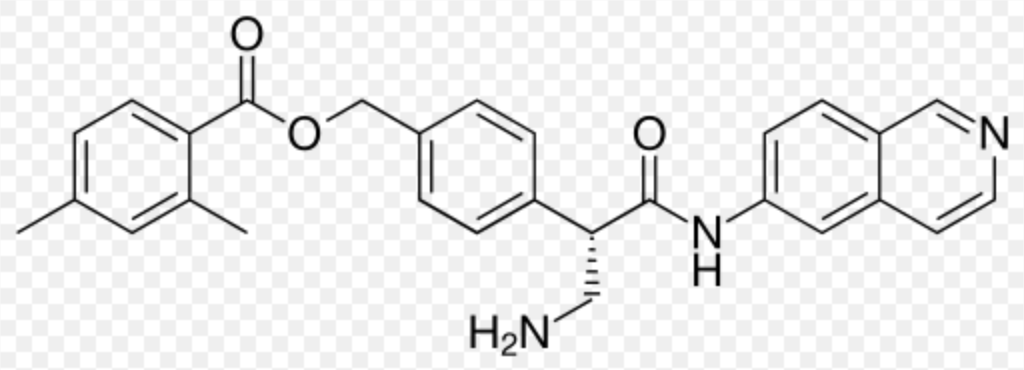
| |
Netarsudil
| |
| Systematic (IUPAC) name | |
| [4-[(2S)-3-Amino-1-(isoquinolin-6-ylamino)-1-oxopropan-2-yl]phenyl]methyl 2,4-dimethylbenzoate | |
| Identifiers | |
| CAS number | |
| ATC code | ? |
| PubChem | |
| DrugBank | |
| Chemical data | |
| Formula | Template:OrganicBox atomTemplate:OrganicBox atomTemplate:OrganicBoxTemplate:OrganicBoxTemplate:OrganicBoxTemplate:OrganicBoxTemplate:OrganicBoxTemplate:OrganicBoxTemplate:OrganicBoxTemplate:OrganicBoxTemplate:OrganicBoxTemplate:OrganicBoxTemplate:OrganicBoxTemplate:OrganicBox atomTemplate:OrganicBoxTemplate:OrganicBox atomTemplate:OrganicBoxTemplate:OrganicBoxTemplate:OrganicBoxTemplate:OrganicBoxTemplate:OrganicBoxTemplate:OrganicBoxTemplate:OrganicBox |
| Mol. mass | ? |
| Synonyms | AR-11324 |
| Pharmacokinetic data | |
| Bioavailability | ? |
| Metabolism | ? |
| Half life | ? |
| Excretion | ? |
| Therapeutic considerations | |
| Pregnancy cat. |
? |
| Legal status |
[[Prescription drug|Template:Unicode-only]](US) |
| Routes | ? |
Mechanism of Action
- Netarsudil is a rho kinase inhibitor, which is believed to reduce IOP by increasing the outflow of aqueous humor through the trabecular meshwork route. The exact mechanism is unknown.
Structure
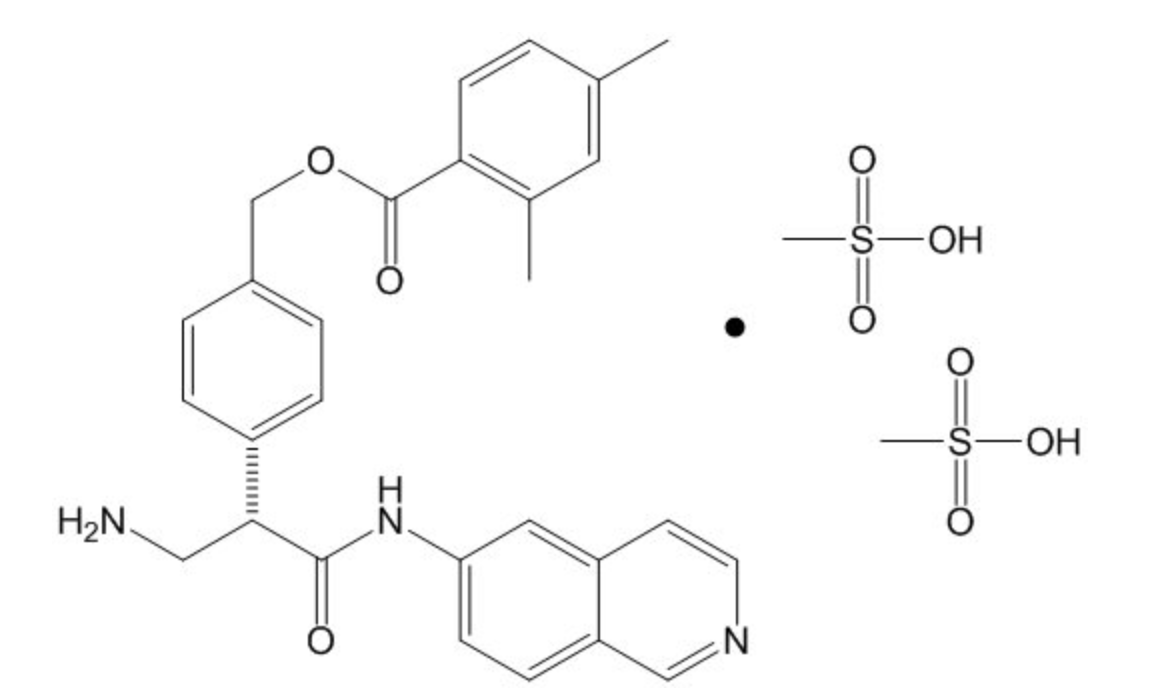
Pharmacodynamics
There is limited information regarding Netarsudil Pharmacodynamics in the drug label.
Pharmacokinetics
Absorption
- The systemic exposures of netarsudil and its active metabolite, AR-13503, were evaluated in 18 healthy subjects after topical ocular administration of RHOPRESSA 0.02% once daily (one drop bilaterally in the morning) for 8 days. There were no quantifiable plasma concentrations of netarsudil (lower limit of quantitation (LLOQ) 0.100 ng/mL) post dose on Day 1 and Day 8. Only one plasma concentration at 0.11 ng/mL for the active metabolite was observed for one subject on Day 8 at 8 hours post-dose.
Metabolism
- After topical ocular dosing, netarsudil is metabolized by esterases in the eye.
Nonclinical Toxicology
Carcinogenesis, Mutagenesis, Impairment of Fertility
- Long-term studies in animals have not been performed to evaluate the carcinogenic potential of netarsudil. Netarsudil was not mutagenic in the Ames test, in the mouse lymphoma test, or in the in vivo rat micronucleus test. Studies to evaluate the effects of netarsudil on male or female fertility in animals have not been performed.
Clinical Studies
- RHOPRESSA 0.02% was evaluated in three randomized and controlled clinical trials, namely AR-13324-CS301 (NCT 02207491, referred to as Study 301), AR-13324-CS302 (NCT 02207621, referred to as Study 302), and AR-13324-CS304 (NCT 02558374, referred to as Study 304), in patients with open-angle glaucoma or ocular hypertension. Studies 301 and 302 enrolled subjects with baseline IOP lower than 27 mmHg and Study 304 enrolled subjects with baseline IOP lower than 30 mmHg. The treatment duration was 3 months in Study 301, 12 months in Study 302, and 6 months in Study 304.
- The three studies demonstrated up to 5 mmHg reductions in IOP for subjects treated with RHOPRESSA 0.02% once daily in the evening. For patients with baseline IOP < 25 mmHg, the IOP reductions with RHOPRESSA 0.02% dosed once daily were similar to those with timolol 0.5% dosed twice daily (see Table 1). For patients with baseline IOP equal to or above 25 mmHg, however, RHOPRESSA 0.02% resulted in smaller mean IOP reductions at the morning time points than timolol 0.5% for study visits on Days 43 and 90; the difference in mean IOP reduction between the two treatment groups was as high as 3 mmHg, favoring timolol.
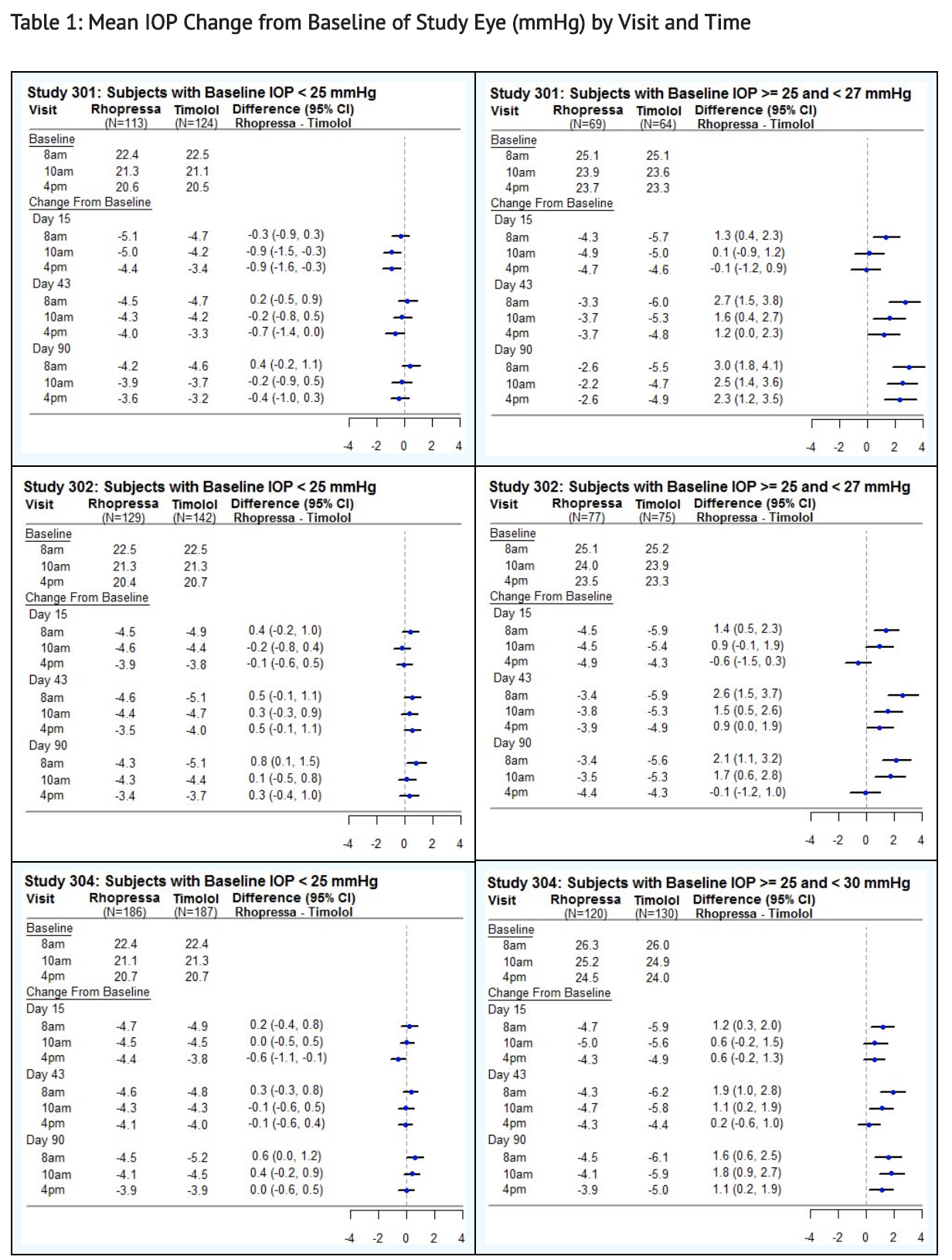
- This table was produced based on the observed data from all randomized subjects who did not have major protocol violations. The treatment differences and two-sided CIs for comparing Rhopressa QD vs Timolol BID 0.5% were based on Analysis of Covariance (ANCOVA) adjusted for baseline IOP.
How Supplied
- RHOPRESSA® (netarsudil ophthalmic solution) 0.02% (0.2 mg per mL) is supplied sterile in opaque white low density polyethylene bottles and tips with white polypropylene caps.
- 2.5 mL fill in a 4 mL container
- NDC # 70727-497-25
Storage
- Storage: Store at 2°C to 8°C (36°F to 46°F) until opened. After opening, the product may be kept at 2°C to 25°C (36°F to 77°F) for up to 6 weeks. During shipment, the bottle may be maintained at temperatures up to 40°C (104°F) for a period not exceeding 14 days.
Images
Drug Images
{{#ask: Page Name::Netarsudil |?Pill Name |?Drug Name |?Pill Ingred |?Pill Imprint |?Pill Dosage |?Pill Color |?Pill Shape |?Pill Size (mm) |?Pill Scoring |?NDC |?Drug Author |format=template |template=DrugPageImages |mainlabel=- |sort=Pill Name }}
Package and Label Display Panel
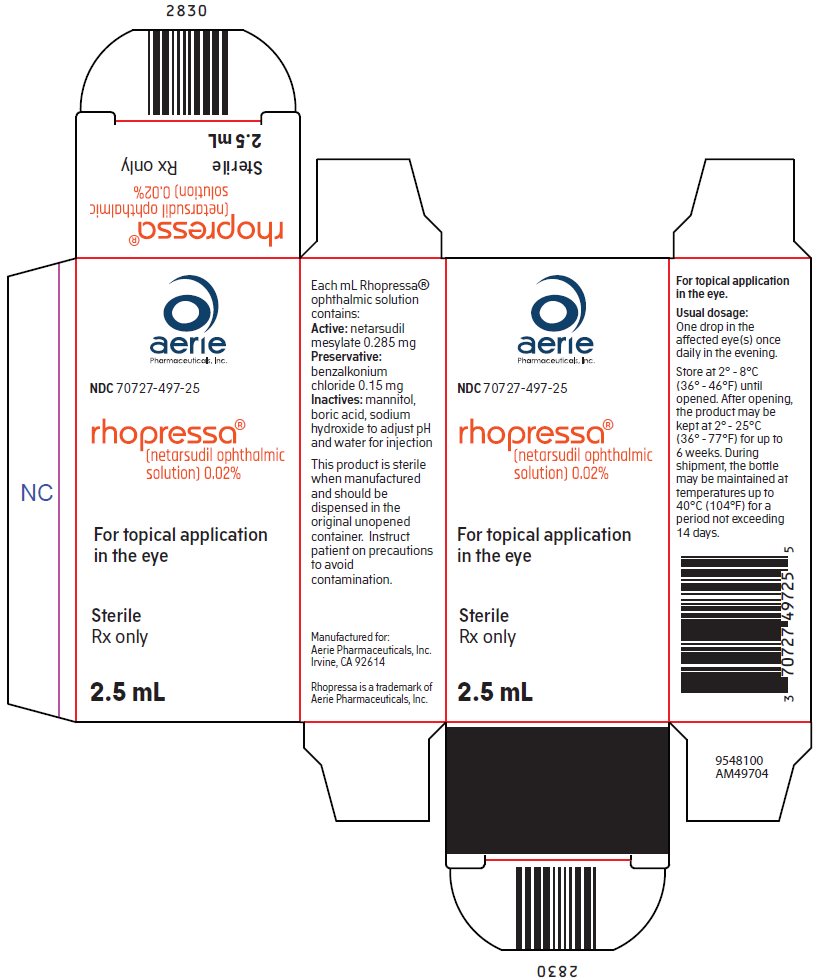
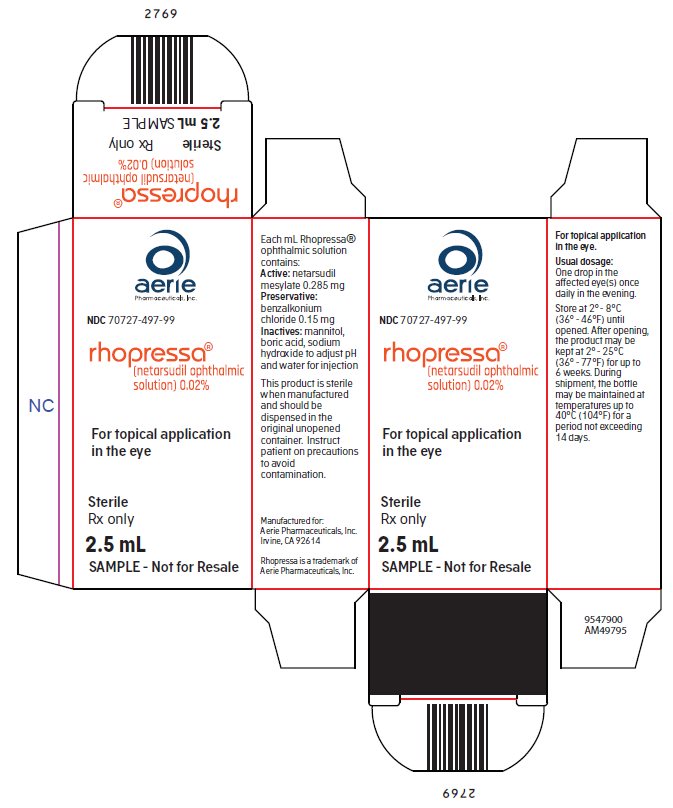
{{#ask: Label Page::Netarsudil |?Label Name |format=template |template=DrugLabelImages |mainlabel=- |sort=Label Page }}
Patient Counseling Information
Handling the Container
- Instruct patients to avoid allowing the tip of the dispensing container to contact the eye, surrounding structures, fingers, or any other surface in order to minimize contamination of the solution. Serious damage to the eye and subsequent loss of vision may result from using contaminated solutions.
When to Seek Physician Advice
- Advise patients that if they develop an intercurrent ocular condition (e.g., trauma or infection), have ocular surgery, or develop any ocular reactions, particularly conjunctivitis and eyelid reactions, they should immediately seek their physician’s advice concerning the continued use of RHOPRESSA.
Use with Contact Lenses
- Advise patients that RHOPRESSA contains benzalkonium chloride, which may be absorbed by soft contact lenses. Contact lenses should be removed prior to instillation of RHOPRESSA and may be reinserted 15 minutes following its administration.
Use with Other Ophthalmic Drugs
- Advise patients that if more than one topical ophthalmic drug is being used, the drugs should be administered at least 5 minutes between applications.
Missed Dose
- Advise patients that if one dose is missed, treatment should continue with the next dose in the evening.
Precautions with Alcohol
Alcohol-Netarsudil interaction has not been established. Talk to your doctor regarding the effects of taking alcohol with this medication.
Brand Names
- Rhopressa
Look-Alike Drug Names
There is limited information regarding Netarsudil Look-Alike Drug Names in the drug label.
Drug Shortage Status
Drug Shortage
Price
References
The contents of this FDA label are provided by the National Library of Medicine.